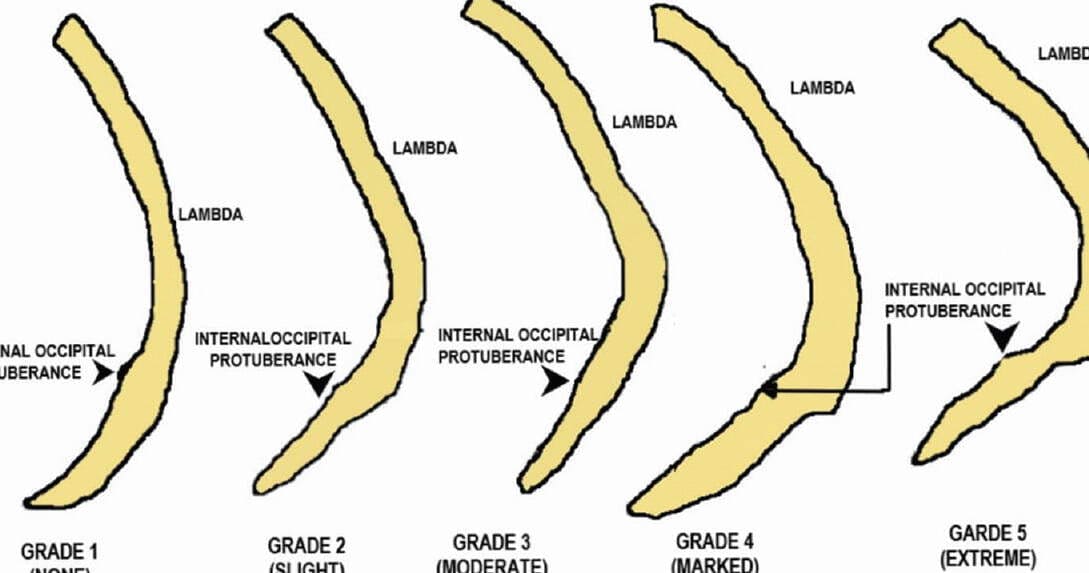Protuberances (known as Protuberanzen in German, derived from the Latin word protubero meaning “blowing up”) are compact accumulations of cold substances that rise and remain suspended above the Sun’s surface due to the presence of its magnetic field.
The exploration of protuberances began with the occurrence of the Solar eclipse on July 8, 1842, when Arago, Erie, and other astronomers observed them as bright pink protrusions encircling the darkened disk of the Moon. While viewing the solar eclipse on August 18, 1868, Pierre Jansen, independently from J. Lockyer, employed a fresh technique to observe prominences outside of the eclipse and deduced that they were composed of gas. Valuable knowledge regarding solar prominences and their rapid transformations was acquired through the use of cinematography, employing the method of slow-motion photography. Currently, the processes taking place within the solar atmosphere are observed and researched by satellites and space stations.
Prominences can be easily seen during total solar eclipses. When there is no eclipse, they can be observed using specialized instruments like prominence spectroscopes, interference filters, extra-eclipse coronographs (such as the Lio coronograph), and chromospheric telescopes. When projected onto the solar disk, prominences appear as dark fibers.
Fibers are elongated dark structures that are clearly visible in the solar chromosphere in the H-alpha hydrogen red line. They are formations of dense and colder plasma that are held above the solar surface by magnetic field loops.
Sorting
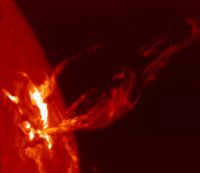
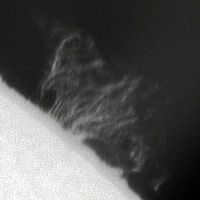
Protuberances exhibit a unique structure composed of constantly moving plasma filaments and clots. They can take on various forms, which can be classified based on their morphology or dynamics.
Based on the type of prominence, velocity, and specific movement patterns, protuberances can be categorized into the following classes:
- Quiescent – these protuberances have slow matter movement and minimal changes in form. They can exist for weeks or even months and are observed across all heliographic latitudes. They can be found far from sunspot groups or near them during the later stages of their development. The kinetic temperature of quiescent protuberances is 15000°.
- Active prominences are characterized by rapid movements of matter flows from the prominence to the photosphere, as well as between prominences. Even quiet prominences can go through an active stage that can last from several minutes to several days. This stage can end with the complete disappearance of the prominence or its transformation into an eruptive prominence. The kinetic temperature of active prominences is approximately 25,000°.
- Eruptive prominences, also known as eruptive prominences, resemble massive fountains that can reach heights of up to 1.7 million kilometers above the surface of the Sun. The movement of matter in these prominences is fast, with speeds reaching hundreds of kilometers per second. Additionally, they can change their shape rapidly. As the prominence rises, it weakens and eventually dissipates. Some eruptive prominences have been observed to undergo sudden changes in the velocity of individual clots. These types of prominences have a short lifespan.
- Coronal, or loop-shaped phenomena, occur above the chromosphere in the form of small clouds, which then merge into a single cloud. From this cloud, individual jets of luminous matter descend to the chromosphere. This entire phenomenon lasts for several hours. Large prominences and energetic coronal ejections are quite rare and occur more frequently near the maximum of the 11-year solar cycle, when there are many sunspots and other active phenomena.
A classification of prominences has been developed at KRAO, taking into account the nature of matter motion and the shape of prominences:
- Type I (which is uncommon) manifests as either a cloud or a plume of smoke. Its formation begins at the base of the substance and spirals upwards to significant heights. The velocity of the substance can reach up to 700 km/sec. When the prominence reaches a height of approximately 100,000 km, fragments of the prominence break away and fall back along paths resembling magnetic field lines.
- Type II takes the form of curved jets that originate and terminate at the surface of the Sun. These nodes and jets move as if they are following magnetic force lines. The clusters’ motion speeds range from a few tens to 100 km/sec. At altitudes of several hundred thousand kilometers, the jets and clusters gradually dissipate.
- Type III resembles a shrub or a tree and can grow to immense dimensions. The clots within it move in a disordered manner, reaching speeds of up to tens of km/sec.
Theory
At present, there is still a lack of a comprehensive theory that can fully explain the diverse range of phenomena associated with solar prominences. It is widely acknowledged that, apart from the influence of gravity, electric and magnetic forces significantly contribute to this phenomenon.
Although the chemical makeup of prominences aligns with that of the reversing layer, the physical conditions within them differ significantly. In the spectrum of calm prominences, the lines of hydrogen and singly ionized calcium dominate, while in prominences associated with sunspots (such as most eruptive ones), the lines of various metals are also prominent. The width, intensity, and other characteristics of these lines suggest that protuberances have temperatures ranging from 6,000 to 8,000 Kelvin and a particle concentration of (1-5)*10 10 cm -3 . The fact that protuberances exist for extended periods of time indicates that their substance is held in place by magnetic forces. Spectroscopic observations have confirmed the presence of magnetic fields in prominences, with strengths reaching several hundred ersteds.
Fascinating information
- The video (download 4.0 MB MPEG) demonstrates the eruption of one of the most renowned prominences, known as “Granddaddy” (Granddaddy)” and observed in 1945 during the peak of the solar cycle.
- During June 1946, astronomers witnessed the highest prominence ever recorded on the Sun. It reached a height of 1.7 million kilometers (Sergei Yazev, director of the astronomical observatory of the IGU).
- Udin W. and Verma V. K. reported on January 25, 1991 (close to the maximum of the solar cycle) that they observed maximum velocities of prominence eruption reaching approximately 1280 km/sec, although it is possible that this refers to the velocity of the wave rather than the matter. (IngentaConnect)
- The SOHO satellite captured two simultaneous prominences on opposite sides of the Sun’s disk for the first time on March 18, 2003. These prominences disappeared after six hours. Astrophysicists are still investigating whether this occurrence was random or dependent. (SciTecLibrary.ru April 2, 2003)
- On April 17, 2009, the TESIS space observatory, aboard the Russian Koronas-Foton satellite, observed the ejection of a massive prominence during the Sun’s deep minimum. This prominence was 50 times the diameter of the Earth and was expelled into interplanetary space (TESIS, download movie 4.0 MB (WMV)).
Sources
Notes
- ↑ The prominence spectroscope, which was specially designed to observe prominences at the edge of the solar disk, had lost its scientific significance by the 1970s.
A breathtaking 140-megapixel depiction of the Sun featuring a massive prominence
Andrew McCarthy and Jason Hansel, two esteemed astrophotographers, joined forces to produce an image of the Sun. The outcome of their collaboration is an awe-inspiring 140-megapixel portrait of our celestial body.
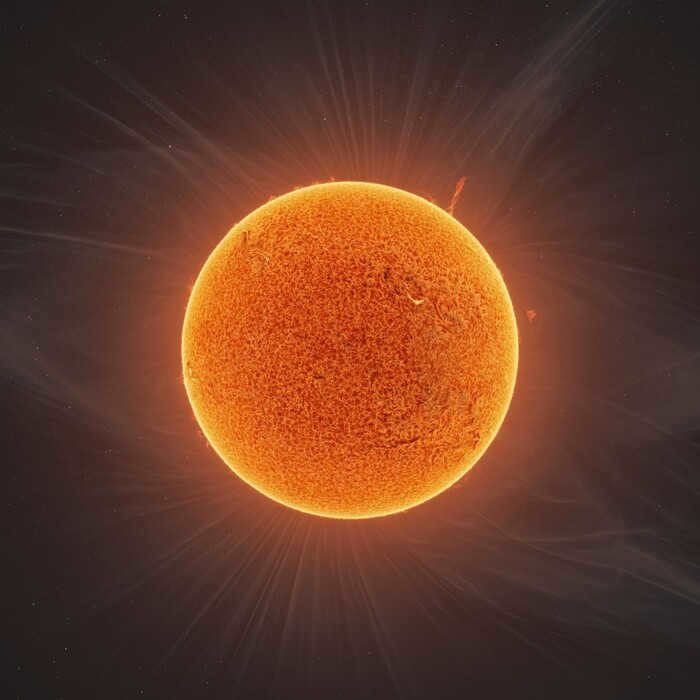
During a five-day period, the photographers managed to capture the Sun, resulting in over 90,000 images of the star. These images were then merged into a single portrait, showcasing the stunning surface of our Sun and the dynamic nature of its various processes.
Upon closer inspection, one can observe a vortex-like structure in the upper right section of the solar disk. This structure is actually a massive prominence, which garnered the attention of amateur astronomers worldwide during its recent formation.
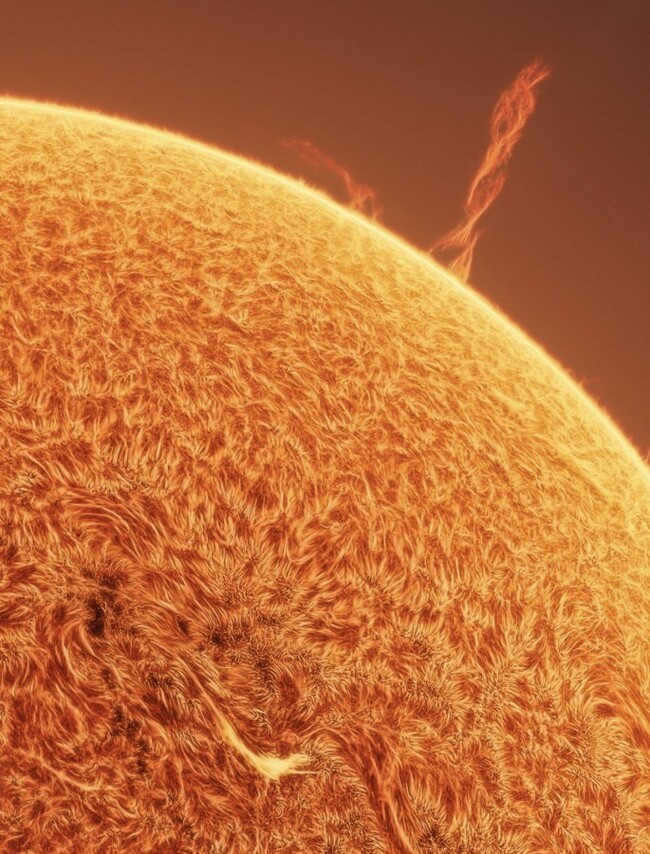
A “solar whirlwind” developed over a period of three days and eventually reached a height of 120,000 kilometers. To gain a better understanding of its magnitude, this is equivalent to the diameter of Saturn or nearly ten times the diameter of our Earth. Subsequently, the prominence descended to the surface of the sun. During its descent, the prominence fragmented into moon-sized pieces, accompanied by a significant release of energy and matter.
Get affordable laptops now!
Choosing an affordable laptop for various work scenarios
It is often said that the increasing prices of laptops resemble a map of the starry sky. Although this may be a joke, we have compiled a list of 12 devices that offer the best value for the money.
By using the promo code PIKABU23, you can enjoy a discount of 800 rubles on home appliances and electronics when placing an order of 5000 or more at Megamarket.
Gaming, performance, and heaviness: handle with caution
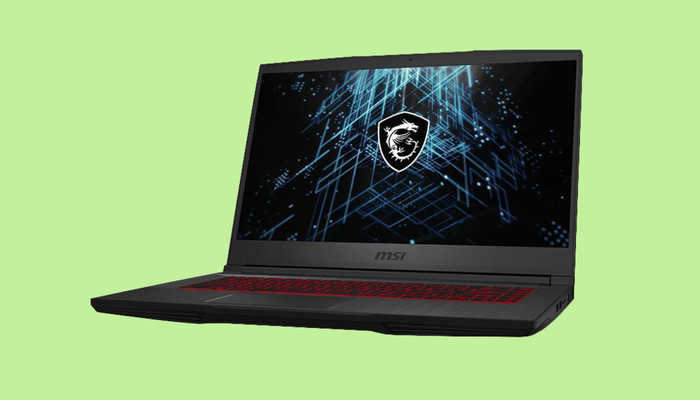
The MSI GF63 Thin takes the top spot on the gaming laptop list – it’s compact (by gaming laptop standards) and powerful. It runs on an Intel Core i5 11400H with integrated UHD graphics, and also features a mobile version of the GeForce RTX 3050 graphics card. With a speedy 16GB DDR4 RAM and a 1920×1080 resolution monitor with a refresh rate of 144 hertz, this laptop is a great portable solution for gaming. Plus, its optimized cooling system ensures that it doesn’t overheat and burn your hands during long gaming sessions.
Introducing the Thunderobot 911 Air D
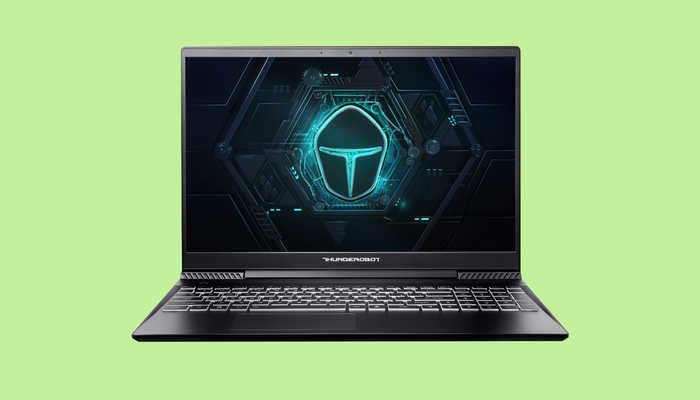
This Chinese brand has decided to test its luck in new markets, and we’re excited about it because it means more options for us! This laptop is equipped with an Intel Core i5 11260H processor and a GeForce GTX 1650 graphics card, along with 8 GB of DDR4 RAM. While there may be a slight performance lag compared to the previous model, the price of this device is significantly lower. The monitor has a refresh rate of only 60 hertz, which may seem low, but considering the budget-friendly graphics card, it’s not a major concern. You’ll still be able to play modern AAA games at medium and high graphics settings without any issues. In fact, our measurements show that the frame rate in almost every game never dropped below 30 frames per second. And if you’re a fan of the first Crysis game, you’ll be happy to know that it can run at maximum settings on this laptop!
The ASUS ROG Strix G513IM is an computer that stands out from the rest.
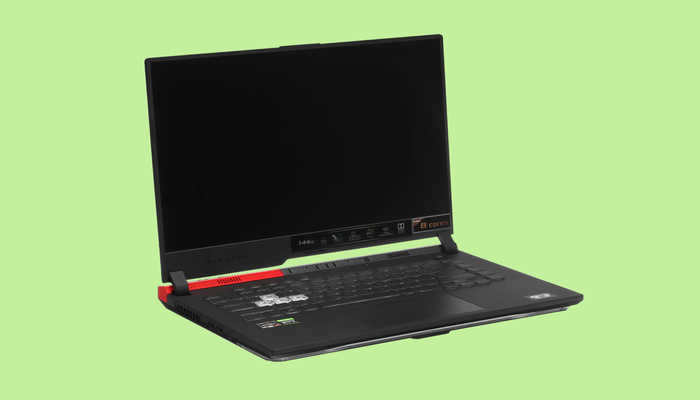
This laptop stands out as a powerful gaming device that proudly showcases its gaming heritage and aims to live up to it, particularly in terms of its appearance. The ROG series is known for its Aura Sync feature, which means the laptop is adorned with LED lighting that can be personalized using the application.
The laptop’s specifications are in line with its price: it boasts an 8-core AMD Ryzen 7 4800H processor, a GeForce RTX 3060 with 6GB video memory, 16GB of RAM, a high-speed 512GB M2 SSD, and a vibrant IPS screen with a 144Hz refresh rate. The combination of these features suggests that this gaming laptop is a solid option that will remain relevant for years to come.
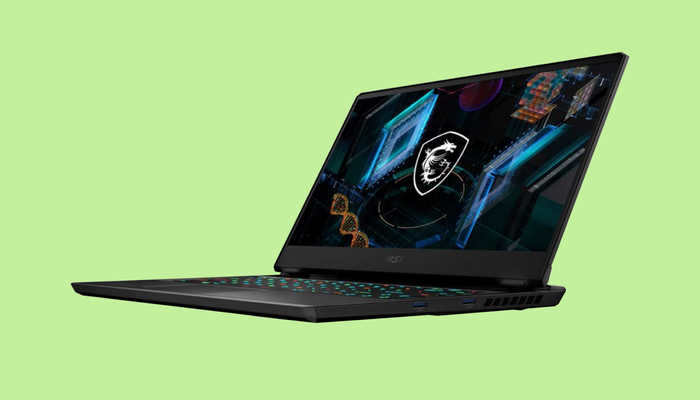
If you are a fan of the Intel brand, take a look at this laptop. It has a more understated appearance compared to the previous model, but the design of the case hints at its gaming capabilities. It is powered by an Intel Core i7 11800H processor, which may not be as powerful as its AMD counterpart, but the GeForce RTX 3070 graphics card compensates for any performance drawbacks.
An ideal choice for globetrotters and fans of collaborative work, the slim and lightweight design of this product sets it apart.
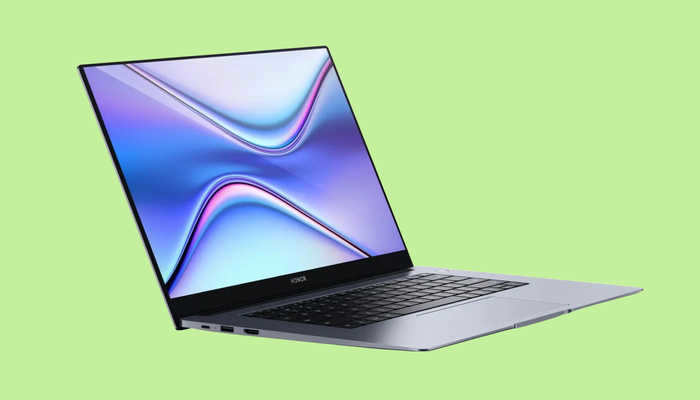
The laptop is practical and well-built, housed in a sleek and compact case with a large bezel-less screen. It features MagicLink technology, which allows Honor smartphone users to easily transfer photos from their phone to the laptop’s desktop for quick editing in Photoshop. Another proprietary technology called Multiscreen enables users to display their smartphone screen on the laptop monitor and control it. The webcam is cleverly hidden under a button next to F6, ensuring privacy for those who are wary of surveillance. The laptop also boasts impressive battery life, providing up to ten hours of active use, and comes with a compact charger for convenience.
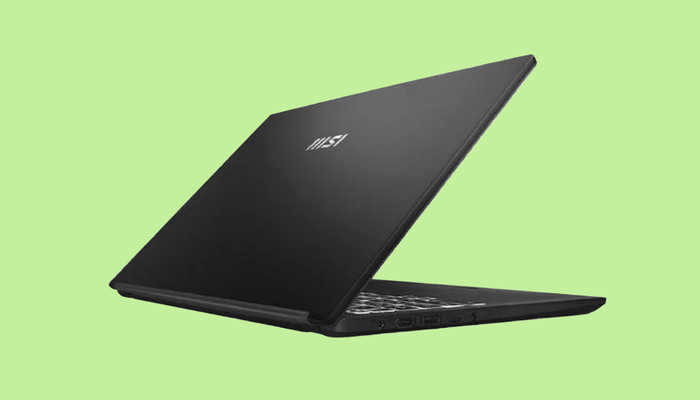
Typically, laptops with similar specifications are often found in larger cases weighing under 2 kg. However, MSI seems to disregard the laws of physics with their Modern 14, which weighs only 1.4 kg. Powered by the AMD Ryzen 5625U processor from the popular line of efficient and powerful notebook processors.
While it may not be considered a typewriter, this ultrabook is capable of video editing and rendering 3D scenes. However, it is not recommended for color correction due to its limited color range. Surprisingly, it can even handle gaming!
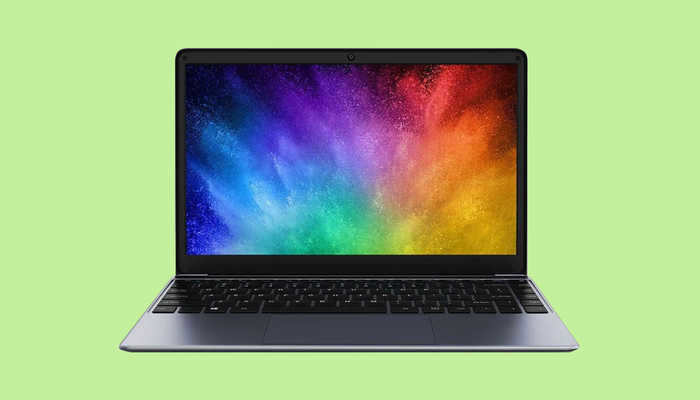
Looking for a budget-friendly and efficient ultrabook to handle office tasks? This ultrabook offers just that and more. With a sensible IPS-display, a spacious touchpad, and compact dimensions slightly larger than an A4 sheet, it’s designed to meet your needs. Plus, it’s equipped with an anti-reflective coating, making it perfect for working in sunny environments. Worried about storage? Don’t be. This ultrabook comes with 256GB of internal memory, which can easily be expanded using the M2 SSD slot located on the underside of the case. And when it comes to battery life, you won’t be disappointed. With up to nine hours of active use, this ultrabook can keep up with your busy schedule. Whether you’re a digital nomad or just someone on the go, this ultrabook is the perfect choice.
For office employees who occasionally work outside the office, there is a standard option available
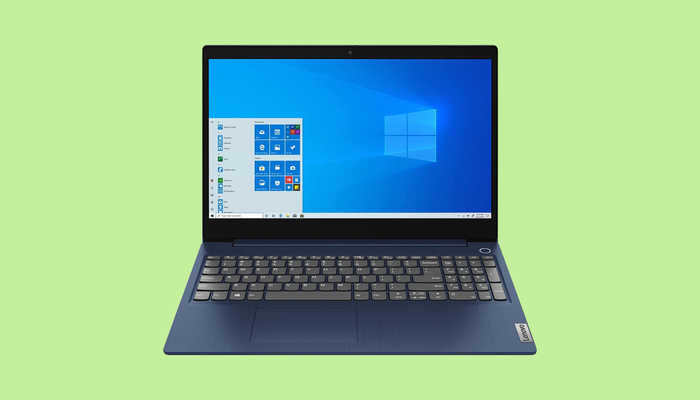
These office laptops are quite popular and frequently used in accounting and sales departments. In this particular case, we have a configuration that includes the minimum set of software required for an office suite. The Intel N4020 processor, with its dual cores, supports DDR4 standard RAM and a sleek 256GB SSD drive. This combination provides a fast and responsive system, ideal for working with documents and accounting systems. However, it does have its limitations and won’t offer much beyond that.
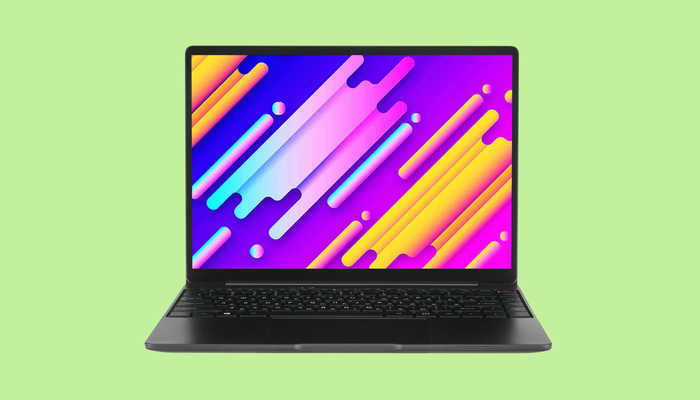
The Chuwi Corebook 14 is a compact and reasonably priced laptop that offers good performance for its price range. It features an Intel Core 1035G1 processor, which is capable of more than just web browsing and typing. It can handle tasks such as simple editing and basic 3D modeling. While the integrated graphics processor is better than most similar models, it is not a dedicated video card, especially for entry-level users.
The display of the Chuwi Corebook 14 is not the brightest, with only 300 nits, so using it in direct sunlight may be difficult. However, it is perfectly suitable for indoor use and looks sleek on a desk. The laptop also includes an HDMI port, allowing users to connect it to a larger screen for presentations and reports.
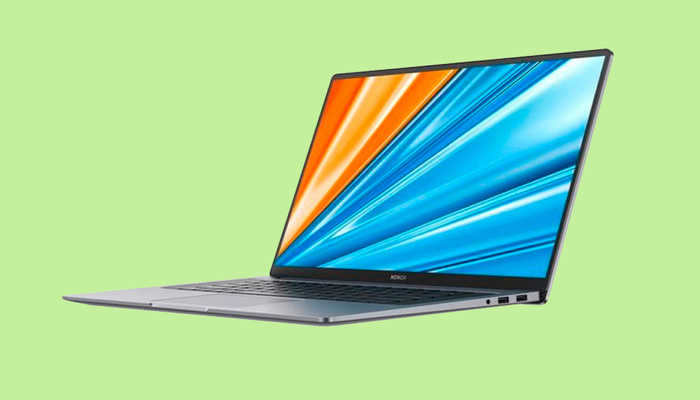

The Honor MagicBook Pro has received an upgrade. It now features a high-performing six-core AMD Ryzen 5 5600H processor, a generous 16GB RAM, and a super-fast SSD. All the notable features of Honor laptops are present, with the exception of the camera which remains in its usual position on the top frame of the screen. While it may not have the same level of performance as more powerful all-rounders, the price of the Honor MagicBook Pro is reflective of its impressive specifications.
Designed for creatives and artists who are willing to bear the burden to ensure they never miss out on inspiration
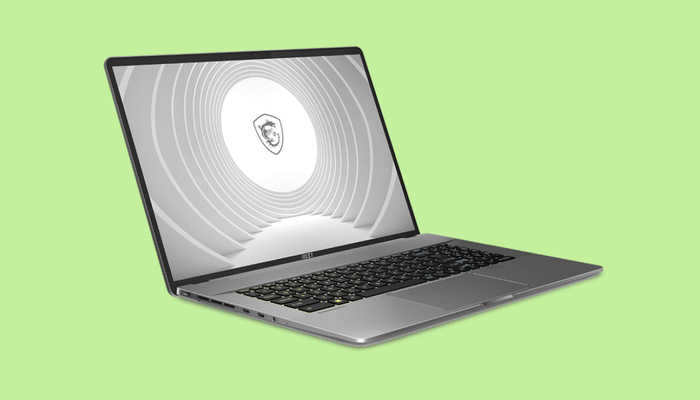
ASUS Zenbook Pro Duo 15 UX582LR is an extraordinary laptop that stands out from the crowd.
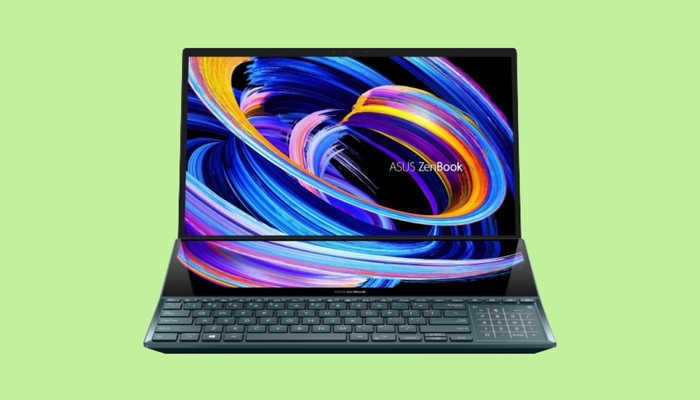
The chipset choice is not unexpected: an Intel Core i7 10870H paired with a GeForce RTX 3070. The laptop comes with 16GB of RAM and a solid-state drive (SSD) storage capacity of one terabyte.
However, what sets it apart is its unique feature – a dual OLED-screen that offers exceptional color accuracy as per the Pantone color institute’s standards. The primary screen boasts a resolution of 3840×2160, while the secondary screen has a resolution of 3840×1100. This opens up a plethora of possibilities in terms of usage scenarios. For instance, one can use the lower screen to display the timeline window, freeing up space on the main screen for the viewport. Alternatively, professionals can utilize the main screen for color correction programs, while keeping the reference material visible on the secondary screen. Additionally, users can conveniently keep their video script right in front of their eyes, rather than relying on memory alone. In the event that the user requires additional monitors, the laptop is equipped with two Thunderbolt 3 USB Type-C ports, enabling easy connectivity with external displays. Despite the modest hardware specifications of the Zenbook Pro Duo in comparison to other professional-grade laptops, it delivers exceptional performance in various benchmark tests.
There are plenty of options available at Megamarket – a wide range of equipment to suit every preference and budget. Take a look, make use of the comparison feature, and don’t forget to apply the promo code PIKABU23, which grants a discount of 800 rubles.
This advertisement is brought to you by LLC “MARKETPLACE” (aggregator) (OGRN: 1167746803180), with its registered address at 105082, Moscow, Spartakovskaya Square, st. 16/15, pp. 6
Solar activity refers to a collection of dynamic and diverse phenomena occurring in the atmosphere of the Sun. One of its manifestations is the presence of distinct filaments within the magnetic field of the solar atmosphere, known as prominences. These prominences become visible at the edge of the solar disk.
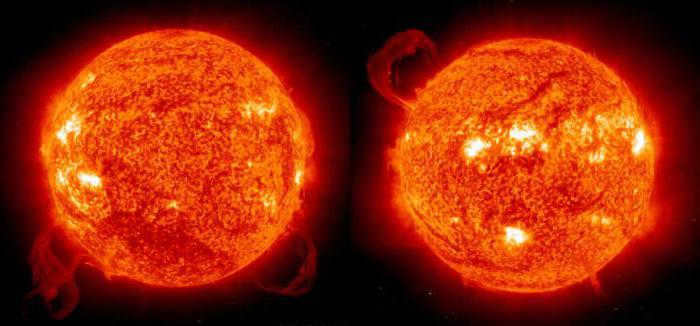
Understanding Protuberances
In 1185, the first recorded observation of peculiar formations during a total solar eclipse was made. Detailed investigations into these formations began in 1842. They were later named protuberances, derived from the Latin word “protubero,” meaning to swell.
Current research has revealed that protuberances are enormous structures made of solar plasma. These massive eruptions rise above the Sun’s surface along the lines of its magnetic field and remain suspended there for a period of time. Some protuberances can linger in the vicinity of the Sun for months without undergoing significant changes in shape.
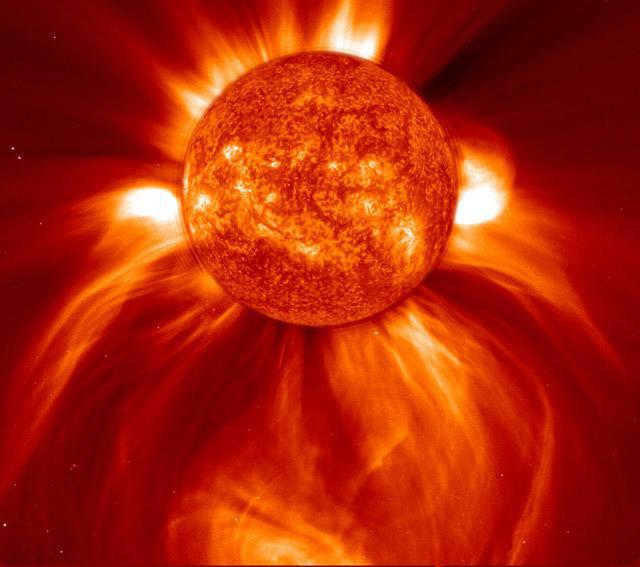
Prominences are fundamentally
Despite extensive scientific research, there is currently no comprehensive theory to explain the diverse nature of prominences and the various phenomena associated with them. Essentially, natural prominences are dark fibers that can be clearly observed in the Sun’s chromosphere. They have a denser and colder structure compared to the surrounding plasma, and their chemical composition reflects the composition of the layer from which they originate. However, their internal physical state is such that the spectrum of some prominences is dominated by hydrogen lines, while others exhibit various metal lines. The longevity of prominences suggests that magnetic forces play a significant role in holding their matter together.
What is the manifestation of prominences?
Prominences on the Sun are observed as bright structures that jut out from its disk. These formations appear darker in contrast to the surrounding matter, as their plasma has a lower temperature.
Compared to the hot corona, prominences are denser and colder. They rise from the Sun’s surface, release some of their material, and eventually descend and vanish. Some prominences can linger in the corona for months, while others, moving at high speeds, persist for weeks. Occasionally, individual prominences with immense velocity undergo sudden explosions.
What is the size of prominences?
Prominences on the Sun are known for their incredible size. Typical examples of these formations can reach heights of up to 40,000 kilometers, with widths of around 200,000 kilometers. There are even instances where prominences have reached heights of 800,000 kilometers. Scientists have observed record-breaking prominences that exceed 3 million kilometers in size. In August 2010, a massive prominence eruption in the shape of a horseshoe was observed from a spacecraft for a duration of 30 hours.

What are solar prominences?
Solar prominences come in various forms. Depending on their appearance and rate of movement, they can be classified into the following types:
- Quiet prominences, which exhibit slow movement and gradual changes in shape, lasting for several weeks or even months;
- Active prominences, characterized by rapid movement of matter and shorter lifespan ranging from a few minutes to several hours;
- Coronal loop prominences, which start as small clouds and eventually merge into a single large cloud, lasting for several hours;
- Eruptive or bursting prominences, resembling massive fountains that erupt rapidly, change shape, and disappear quickly.
There are three types of formations depending on their shape and the movement of matter within them:
- Formations resembling spiraling jets of smoke or clouds that can reach great heights.
- Curved jets and knots that protrude from the solar surface. These formations typically originate and dissipate along magnetic force lines.
- Large formations that resemble trees or shrubs. The substance within these formations moves chaotically at speeds of only a few tens of km/s.
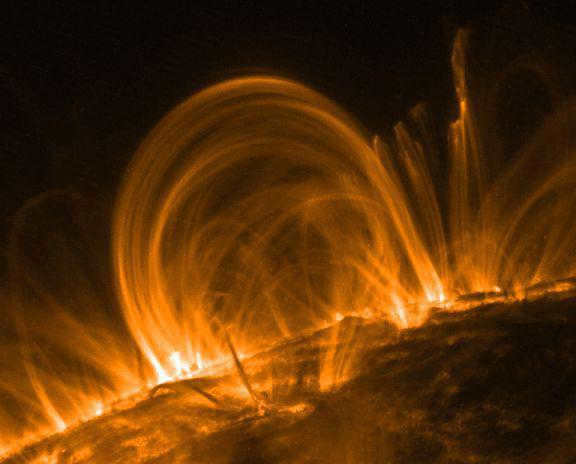
How to view solar prominences?
Solar prominences are a manifestation of the Sun’s activity and can be viewed during a total solar eclipse, although this is a rare occurrence. To overcome this rarity, scientists have developed spectral devices that simulate artificial eclipses. These telescopes, made from a specialized glass without microbubbles, are equipped with a black disk that mimics the Moon. During the observation process, the disk slowly moves across the Sun, allowing the instruments to only see the light emitted from the Sun’s corona.
Observers are treated to a breathtaking sight – the mesmerizing spectacle of prominences dancing on the surface of the Sun. Beyond the silhouette of the moon, one can clearly make out intricate formations of vibrant pink hues, resembling either fiery flames or colossal clouds erupting from the Sun’s uppermost layers.
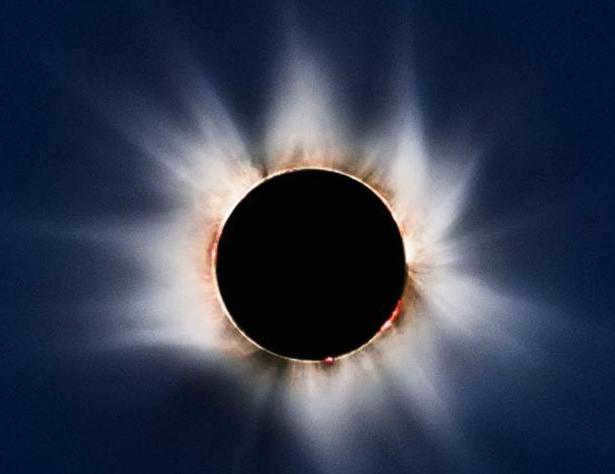
Coronal arc-shaped prominences can be observed during the peak of the Sun’s 11-year activity. This rare and incredibly beautiful phenomenon takes the form of a massive cloud with descending jets, appearing in the Sun’s corona above its chromosphere.
For astronomers, the phenomena occurring in the solar corona have long remained a mystery. Protuberances, as they are called, were associated with the secrets held by our star, the Sun. It is only in modern times, with the help of satellites and space stations, that most of these mysteries have been uncovered.
There are still countless discoveries waiting to be made, both in the vast expanse of the universe and within our very own solar system.
A stunning portrait of the Sun, capturing a giant prominence, with a resolution of 140 megapixels.
Renowned astrophotographers Andrew McCarthy and Jason Hansel came together to produce a magnificent depiction of the Sun. The outcome of their partnership is a breathtaking 140-megapixel portrayal of our celestial body.

The Sun was photographed for a period of five days, resulting in over 90,000 images of the star. These images were then combined to create a stunning portrait that showcases the surface of our beloved Sun and its dynamic processes.
Upon closer inspection, observers will notice a mesmerizing vortex-like structure situated in the upper right section of the solar disk. This structure is actually a massive prominence, which attracted the attention of amateur astronomers worldwide as it formed last week.

A “solar vortex” developed over a period of three days, eventually reaching a towering height of 120,000 kilometers. To provide some perspective, that’s equivalent to the diameter of Saturn or nearly ten times the diameter of our Earth. Eventually, the prominence descended back to the surface of the sun. During its descent, it fragmented into individual pieces roughly the size of the Moon, accompanied by a vigorous release of energy and matter.
Great deals on laptops
Choosing an affordable laptop for various work scenarios
It’s often said that the skyrocketing prices of laptops can resemble a map of the starry sky. While this may be a humorous exaggeration, we have curated a list of 12 devices that offer great value for the money.
Take advantage of the PIKABU23 promo code to receive a discount of 800 rubles on home appliances and electronics when you make a purchase of 5000 rubles or more at Megamarket.
Gaming, performance, and heavy: handle with caution

The first item on the gaming laptop list is the MSI GF63 Thin. It is compact for a gaming laptop and packs a powerful punch. It is powered by an Intel Core i5 11400H with integrated UHD graphics, and it also features a mobile version of the GeForce RTX 3050 graphics card. With a high-speed 16GB DDR4 RAM and a 144 hertz monitor with a resolution of 1920×1080, this laptop is perfect for gaming on the go. Additionally, it has an optimized cooling system that prevents it from getting too hot and burning your hands during long gaming sessions.
Next on the list is the Thunderobot 911 Air D.

We are pleased to introduce a popular Chinese brand that has decided to expand its reach. This brings us more options when it comes to choosing a laptop! This particular model features an Intel Core i5 11260H processor and a GeForce GTX 1650 graphics card, along with 8GB of DDR4 RAM. While there may be some noticeable differences compared to the previous model, the price of this device is significantly lower. The monitor has a refresh rate of 60 hertz, which may be a bit on the lower side, but considering the budget-friendly graphics card, this shouldn’t be a major concern. You’ll still be able to enjoy modern AAA games at medium to high graphics settings without any issues. Our measurements have shown that the frame rate in almost every game stays above 30 frames per second. And if you’re a fan of Crysis, you’ll be happy to know that it will run smoothly at maximum settings on this laptop!
The ASUS ROG Strix G513IM is a gaming laptop designed for high-performance gaming.

The ROG series of laptops is known for its powerful gaming capabilities, and the ROG Aura Sync takes this to the next level. This laptop is equipped with LED lighting that can be customized using the application, allowing you to create a unique and personalized gaming experience.
In terms of performance, the laptop lives up to its price tag. It features an 8-core AMD Ryzen 7 4800H processor, a GeForce RTX 3060 with 6GB of VRAM, 16GB of RAM, a 512GB high-speed M2 SSD, and a vibrant IPS screen with a 144Hz refresh rate. These specifications make it a solid gaming laptop option that will remain relevant for years to come.

If you are a fan of the “blue” team represented by Intel, then this laptop is worth considering. It may not have the flashy appearance of the previous model, but its design hints at its gaming capabilities. Powered by the Intel Core i7 11800H, it may not match its AMD counterpart in terms of specifications, but it compensates for it with the GeForce RTX 3070 graphics card.
Perfect for globetrotters and fans of shared workspaces, this sleek and portable device is a must-have.

Functional and well-built, housed in a sleek and compact chassis with a spacious bezel-less display. It boasts the MagicLink feature, a delightful addition for Honor smartphone enthusiasts. This feature enables seamless transfer of photos from the phone directly to the laptop desktop for convenient Photoshop editing. Moreover, the laptop incorporates Multiscreen technology, allowing users to mirror and control their smartphone screen on the monitor. To ensure privacy, the webcam is cleverly concealed under the button adjacent to F6. Additionally, the laptop offers impressive battery life, providing up to ten hours of active usage, along with a compact charging unit.

Typically, laptops with similar specifications can be found in larger cases weighing under 2 kg. However, MSI seems to disregard the laws of physics with their Modern 14, weighing in at just 1.4 kg. Powered by the AMD Ryzen 5625U, a popular and efficient processor for notebooks, this ultrabook is more than just a typewriter. It has the capability to handle video editing and 3D rendering, although it’s not recommended for color correction due to its limited color range. And believe it or not, it can even handle gaming!

An economically priced and highly efficient ultrabook designed for office tasks. It features a sensible IPS display, a spacious touchpad, and compact dimensions that are just slightly larger than an A4 sheet of paper. Additionally, it has been optimized for use outdoors with its anti-reflective coating, making it suitable for working in the sun. The laptop comes with 256GB of internal storage, which can easily be expanded using the M2 SSD slot located on the underside of the case. It charges quickly and has a battery life of up to nine hours, making it an ideal choice for digital nomads and those on the go.
Standard, for office employees who occasionally work away from the office

An office laptop line that is widely utilized in accounting and sales departments is quite popular. In this particular case, we have a configuration with the basic minimum requirements for an office suite of software. The Intel N4020 processor, equipped with two cores, supports DDR4 RAM and a sleek 256GB SSD drive. This configuration ensures a fast and responsive system, making it convenient for working with documents and accounting systems. However, it is important to note that the capabilities of this laptop are limited to these tasks only.

The Chuwi Corebook 14 is a compact laptop that offers good performance for its price range. The Intel Core 1035G1 processor is capable of handling tasks beyond just web browsing and typing, such as simple editing or basic 3D modeling. While the integrated graphics processor is better than most others in its class, it is not a dedicated video card, especially not at the entry level.
Working with the laptop under direct sunlight may not be ideal due to its display, which has a brightness level of only 300 nits. However, it is perfectly suitable for indoor use and looks clean and professional in a workplace setting. Additionally, the laptop includes an HDMI port for easily connecting it to a larger screen for presentations or displaying reports.

Honor MagicBook Pro model has been upgraded. It now features a robust six-core AMD Ryzen 5 5600H processor, a spacious 16GB RAM, and a lightning-fast SSD. All the signature features of Honor laptops are present, with the camera placed in its usual spot – the top frame of the screen. While it may fall slightly short in terms of performance for power users, the price is in line with its specifications.
Exclusive for individuals in the creative field and artists who are willing to bear the burden in order to ensure they never miss out on any moment of inspiration

ASUS Zenbook Pro Duo 15 UX582LR
can be rephrased as
The 15-inch ASUS Zenbook Pro Duo UX582LR
.

It’s no surprise that the package includes an Intel Core i7 10870H processor paired with a GeForce RTX 3070 graphics card. The laptop also comes with 16 GB of RAM and a terabyte of SSD storage.
However, its main feature lies in its dual OLED-screen that offers precise color reproduction in line with the Pantone color institute standards. The primary screen boasts a resolution of 3840×2160, while the secondary screen measures 3840×1100. There are numerous use cases for this innovative design, such as displaying the timeline window on the secondary screen to free up space for the main viewport. It’s also ideal for working with color correction programs on the main screen while utilizing the secondary screen for reference. Additionally, you can have your video script right in front of your eyes instead of trying to remember it. In case the user requires more display real estate, the laptop is equipped with two Thunderbolt 3 USB Type-C ports, allowing for the connection of external monitors. Despite its relatively modest hardware specifications compared to professional standards, the Zenbook Pro Duo delivers outstanding performance in benchmarks.
There are numerous options available at Megamarket – a wide range of equipment to suit every preference and budget. Take a look, utilize the comparison feature, and don’t forget to take advantage of the promo code PIKABU23, which provides a discount of 800 rubles.
Advertisement provided by MARKETPLACE LLC (aggregator) (OGRN: 1167746803180), with a registered address at 16/15 Spartakovskaya Square, Moscow, 105082, Russia.
This article provides an explanation of a solar prominence, its potential dangers to individuals, and the various indicators used to classify it.
The Sun
Life has thrived on our planet for nearly four billion years, and there are numerous factors that have contributed to its origin and continuation. These include the climate, atmospheric gas composition, the planet’s rotational period, its gravitational pull, and, of course, its distance from the Sun. The Earth is situated in what scientists refer to as the habitable zone, which is an optimal distance from the Sun that allows for the comfortable existence of a wide range of biological species. The fate of planets that are located too close to their central star can be observed by looking at Mercury – a scorched and desolate world.
It is evident that these factors together create a highly intricate and intricate system, where each component must maintain its fragile equilibrium for the progression of life on our planet to persist.
Outgrowths

However, it is important to acknowledge that there exist numerous apparent and concealed hazards that can disrupt the delicate equilibrium of this system. Moreover, on the Sun, there frequently occur phenomena that pose a threat to all forms of life, not solely to humans. An illustrative example of such a phenomenon is the solar or magnetic storms. These disturbances often negatively impact individuals who are sensitive to changes in weather conditions, as well as various types of equipment. During these storms, prominences detach from the Sun and propel towards nearby celestial bodies. Thankfully, the majority of these prominences are relatively small in size, and therefore, the likelihood of tragic consequences is significantly reduced. In this article, we will delve into the dangers associated with prominences and explore their characteristics in greater detail.
Explanation
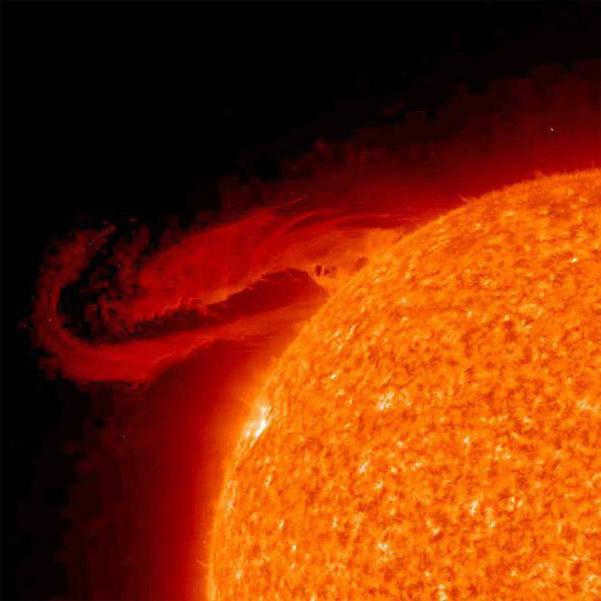
Protuberances refer to dense condensations of colder matter compared to the Sun’s surface. These structures rise above the star’s surface during periods of activity and are held in place by its magnetic field. Essentially, they can be described as massive jets of hot solar matter that are anchored by the gravitational pull of the star. However, during periods of intense solar activity, streams of plasma can erupt from the Sun’s photosphere and travel in various directions, including towards Earth. This phenomenon is known as a magnetic or solar storm.
Description
The following is a brief overview of the product’s features and functionality.
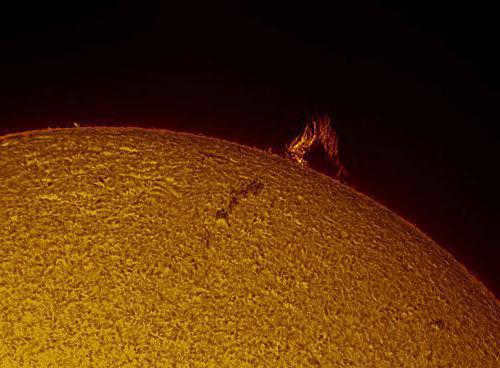
Prominences were first mentioned in scientific literature during a solar eclipse in 1185. However, limited scientific knowledge and technology at the time hindered further study of this phenomenon. It wasn’t until the mid-19th century that prominences were extensively studied. In 1868, Pierre Janssen pioneered a new method of observing prominences without the need for a solar eclipse, leading to the discovery that they exist in a gaseous state.
Given the nature of prominences, their comprehensive study became possible only with the advancements in scientific and technological progress, such as slow motion photography and artificial near-Earth observation satellites.
Solar prominences become easily visible during total solar eclipses. These unique events are observed using specialized equipment such as prominence telescopes, filters, coronographs, and chromospheric telescopes. When projected onto the Sun’s surface, prominences appear as elongated dark fibers of varying thickness. Therefore, ordinary telescopes can only capture the phenomenon of prominences during a total solar eclipse.
Now that we understand what solar prominences are, let’s explore their different types.
Types
Prominences can be described as wispy structures resembling filaments or clusters of plasma in various shapes. They are in constant motion and continuously change their form. Prominences are classified based on their dynamic and morphological features. Let’s explore their classification by appearance, motion characteristics, and speed:
- Calm. In this type, the substance moves at a slower pace. The changes in form occur gradually. Calm prominences typically have a lifespan ranging from a few weeks to several months. They can be observed at all heliographic latitudes, but are most commonly found near sunspots in the advanced stage of development. The temperature of calm prominences is approximately 15,000 degrees Celsius.
- Active. The photo below shows a remarkable phenomenon called an active prominence. What distinguishes this prominence is that plasma streams flow rapidly from the base of the geyser towards the photosphere and between different prominences. These plasma streams reach incredibly high speeds and have a temperature of 25,000 degrees Celsius. Interestingly, many active prominences originate from quiescent ones, but their lifespan is relatively short, lasting from a few minutes to a day.
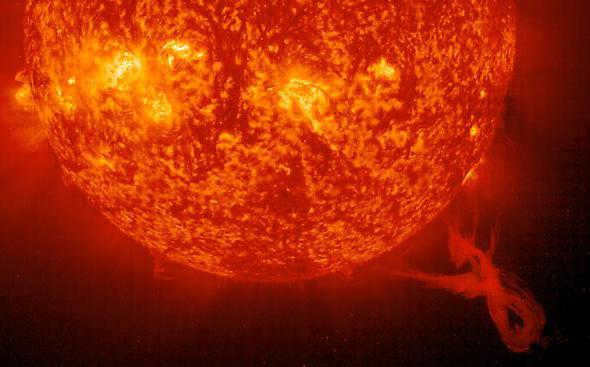
- Eruptive. When talking about their appearance, these prominences can be compared to massive fountains that are over one and a half million kilometers tall above the surface of our star. The plasma moves at speeds of hundreds of kilometers per hour, and their shape changes rapidly. They have a short lifespan, and as they grow taller, they eventually dissipate completely.
- Loop-shaped prominences are seen as small clouds above the chromosphere. Over time, they often merge into a larger cloud, which then releases streams of glowing gas towards the chromosphere. These phenomena rarely last more than a few hours.
Now we have a better understanding of the solar corona and the various types of prominences it possesses.
The Concept of Emergence
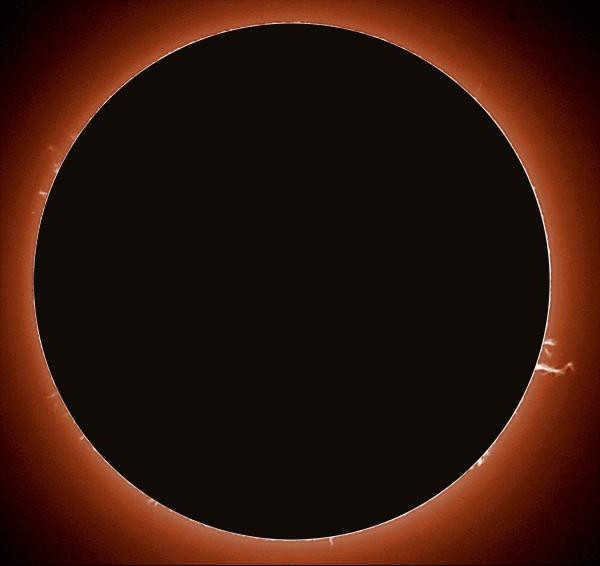
Despite extensive research on solar activity, a comprehensive theory explaining the occurrence of prominences and related phenomena is still lacking. This can be partially attributed to the combined influence of electric and magnetic forces along with the Sun’s gravitational pull.
The chemical composition of a prominence corresponds to the layer from which it originates. However, the composition is often linked to the physical conditions under which the phenomenon exists. For instance, quiet prominences are characterized by hydrogen and ionized calcium lines in their spectrum, while prominences associated with sunspots exhibit prominent lines of various metals.
The substance’s prolonged existence in various forms suggests that it is being retained by the star’s magnetic force, a hypothesis that has been substantiated by multiple spectroscopic observations.
Potential Hazard

As previously discussed, a prominence is a feature of the Sun’s chromosphere and is involved in various physical processes. The main concern lies with those prominences that detach from the surface of the Sun and venture into outer space. Depending on their intensity, these detached prominences can disrupt satellites in Earth’s orbit and pose a threat to the crew of the International Space Station (ISS). Additionally, when interacting with Earth’s magnetosphere, prominences can generate powerful magnetic storms that have negative effects on individuals sensitive to weather changes, as well as interfere with radio communication systems and other electronic devices. Thankfully, prominences with the potential to detach from the Sun’s surface and cause such damage are exceedingly rare.

